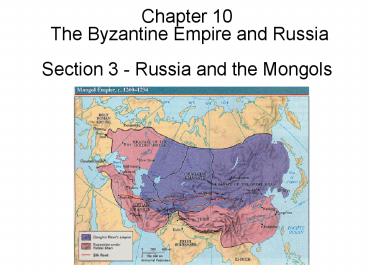Chapter 10 The Byzantine Empire and Russia Section 3 Russia and the Mongols - PowerPoint PPT Presentation
1 / 22
Title:
Chapter 10 The Byzantine Empire and Russia Section 3 Russia and the Mongols
Description:
In protecting the Kievan state, Vladimir was merciless against his enemies. ... In the 1300s Lithuania and Poland seized. territory from western Kievan Russia ... – PowerPoint PPT presentation
Number of Views:871
Avg rating:3.0/5.0
Title: Chapter 10 The Byzantine Empire and Russia Section 3 Russia and the Mongols
1
Chapter 10 The Byzantine Empire and
RussiaSection 3 - Russia and the Mongols
2
- The Story Continues
- When Yaroslav the Wises rule ended in A.D. 1054,
Kiev declined in power. During the first quarter
of the A.D. 1100s, however, the city enjoyed a
brief revival under the leadership of Vladimir
Monomakh, who ruled from A.D. 1113 to A.D. 1125.
In protecting the Kievan state, Vladimir was
merciless against his enemies. As a result, Kiev
was often at war during his reign.
3
I. Attacks on Kiev
- In the 1000s, Kiev declined in power due to
- infighting by princes
4
I. Attacks on Kiev
- The Polovtsy, a Turkish people, took control of
- the area south of Kiev in 1055 and interfered
- with trade
5
I. Attacks on Kiev
- Vladimir Monomakh, a Kievan ruler in the early
- A.D. 1100s, ruthlessly campaigned against the
- Polovtsy
After the Battle with the Polovtsy
6
I. Attacks on Kiev
- Mongols, led by Batu, conquered the
- weakened Kiev about 1240
7
I. Attacks on Kiev
- The Mongols
- controlled Kievan
- Russia until the late
- 1400s and greatly
- influenced Slavic
- society
8
I. Attacks on Kiev
- The Mongols imposed heavy taxes but
- allowed the Slavs to keep their government
- and customs
9
I. Attacks on Kiev
- The Mongols built roads and improved
- communication and taxation methods
10
I. Attacks on Kiev
- In the 1300s Lithuania and Poland seized
- territory from western Kievan Russia
11
I. Attacks on Kiev
- There were also religious conflicts - The Poles
- were Roman Catholic, while the Slavs were
- Eastern Orthodox
12
II. The Rise of Moscow
- As Mongol rule grew weaker, Moscow became
- a major Russian principality under Ivan I
13
II. The Rise of Moscow
- In 1328, Ivan was given the title Great Prince,
- and the leader of the Orthodox church moved
- to Moscow
14
II. The Rise of Moscow
- In the late A.D. 1400s, Ivan III (Ivan the
- Great) united many principalities and became
- the first ruler of independent Russia
15
II. The Rise of Moscow
- Ivan the Great was an absolute monarch who
- expanded Russia through military conquest
16
II. The Rise of Moscow
- In 1533 Ivan IV (Ivan the Terrible) became
- ruler of Russia and took the title of czar
17
II. The Rise of Moscow
- Ivan IV developed a modern legal code,
- renewed trade with western Europe and
- opened Siberia to settlement
18
II. The Rise of Moscow
- Ivan formed a personal group of civil servants,
- the oprichniki, who arrested boyars and gave
- their land to Ivans supporters
19
II. The Rise of Moscow
- By 1500, the Orthodox Church in Russia was
- a major landowner
Saint Basil's Cathedral, a Russian Orthodox
church in Moscows Red Square
20
II. The Rise of Moscow
- The church became independent from
- Constantinople, and Russian bishops began
- choosing their own patriarch
His Holiness Patriarch of Moscow and all Russia
Alexy II
21
II. The Rise of Moscow
- When Constantinople fell to the Ottoman
- Turks in 1453, Russians proclaimed Moscow
- the third Rome
22
II. The Rise of Moscow
- As the third Rome, Moscow claimed it would
- bring the light of the Christian orthodox faith
to - the world
Russian Orthodox Cross































